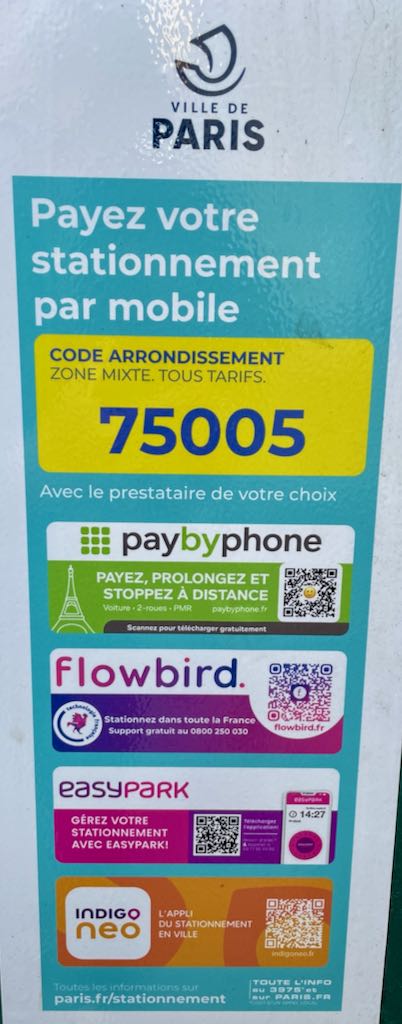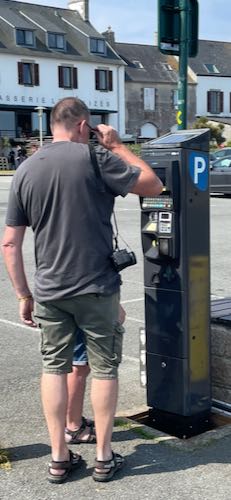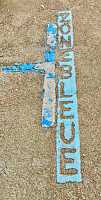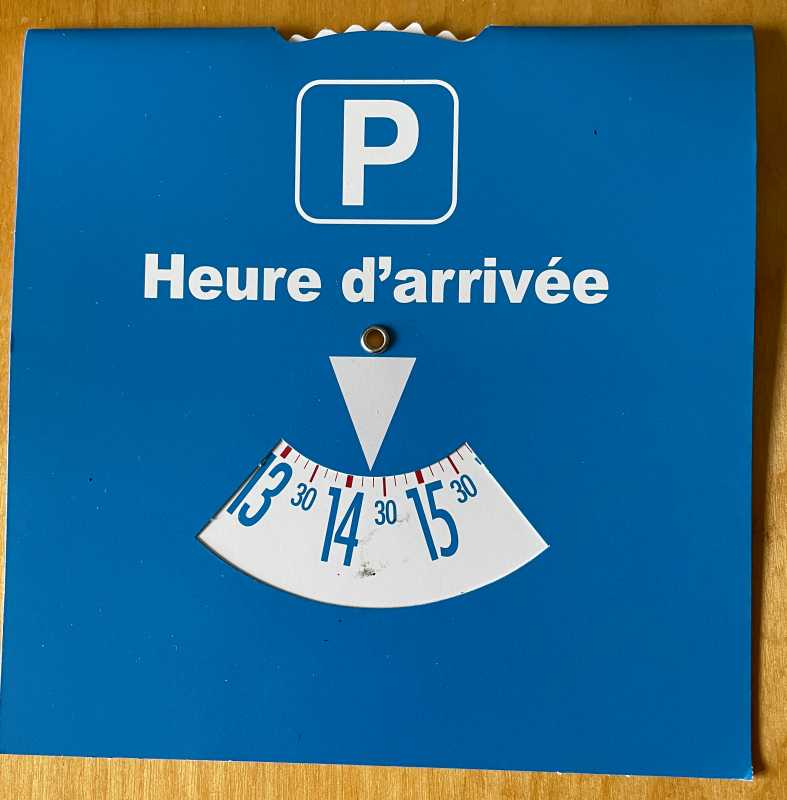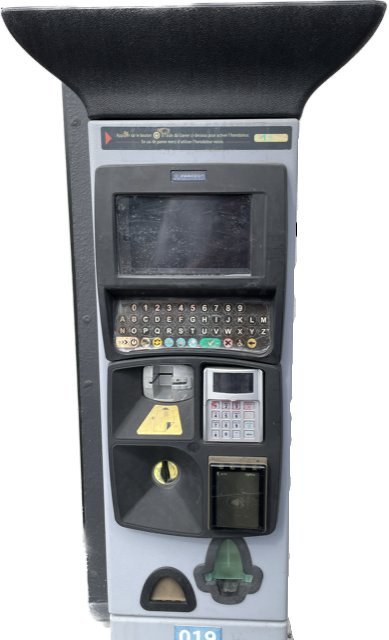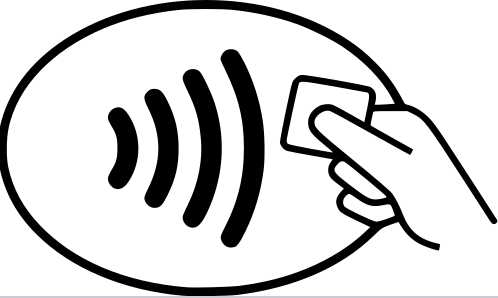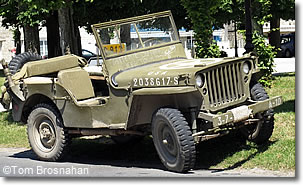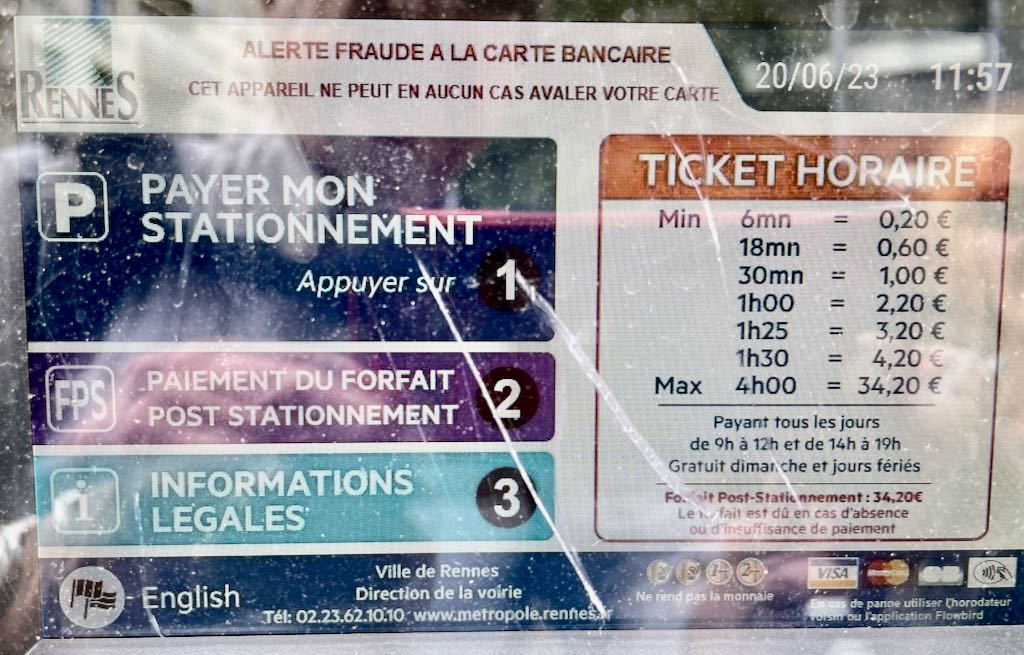 |
Parking a Car in France | |
| Car parking in car parks/garages and parking lots is well organized, but parking on a street may require use of the dreaded horodateur (parking ticket machine), which can seem utterly inscrutable! Paying by smartphone app can be easier. Please read these instructions! | ||
|
|
|
Parking Lots & GaragesIn cities, large multi-level car parking lots are common, whether above- or underground. Signs point the way to them, sometimes giving the name of the operating company (two large companies are Effia and Indigo neo), name of the parking facility, and in some cases, the number of parking spaces available at the moment. In the more sophisticated garages, lights over vacant spaces will lead you right to a vacant one. Smartphone parking apps can also guide you right to a place. Rates are clearly indicated at the parking facility entrance. Take a ticket, carry it with you, and pay the fee at a machine near a pedestrian entrance to the facility as you return to your car. Note that to use a credit/debit card to pay the fee, it must be a credit card with a chip. More... You may also be able to use a smartphone parking app. The most-used app in France appears to be Flowbird, used in many large and small cities (but not in all towns or villages—see below). If you don't have a credit card with a chip, have a good supply of 2€, 1€, and smaller coins. After inserting sufficient coins, your parking ticket will be returned to you by the machine. Drive to the parking facility exit, insert the paid ticket in the gate machine, and the gate/barrier will lift so you can exit.
Street ParkingParking spaces are indicated on some streets and in some surface parking lots by white lines. Virtually all spaces on streets, except in the smallest towns and villages, are labeled payant (metered for pay). Parking lots outside the town or city center may be free (gratuit) or pay. Smartphone Parking AppsIf you plan to park numerous times in a variety of cities, you may wish to download and use a smartphone parking app. The most-used parking app in France appears to be Flowbird, although other apps (often EasyPark), and multiple apps, are also used in some cities. Download the app, set up an account, establish a payment method (credit/debit card) and input the license plate number of your vehicle before you use the app to park. The advantages of using a parking app: (1) You don't need the correct coins or euro notes to feed into a horodateur; (2) You don't need to wait in line to use the horodateur, or struggle to understand it; (3) You can extend your parking time without returning to your vehicle. By the way, if you use a parking app you won't receive and you don't need a paper parking receipt to put in the windscreen of your car. The parking authorities monitor your parking time via the Internet. But be sure to set up your parking app account before you use it for parking, if possible. Zone BleueZone bleue, marked by signs and/or blue stripes on the street surface, means free but limited-time parking. Vehicles must display a traditional blue parking disc (disque de stationnement) noting time of arrival. After the allotted free time, the vehicle must be removed or be subjected to a fine.
If you don't want to bother with the disc and time limit, find a parking area outside the center zone bleue where parking is not time-limited. Complicated TimingNote that you may not be charged for lunch time, the hour or two when shops may be closed; nor for nighttime; nor for Sundays and holidays; and in certain places the first 30 minutes or hour may be free. So if you park at 11:00am and you pay for three hours' parking, but lunchtime is free, your end time will be 15:00 (3:00pm), not 14:00/2:00pm. Likewise, if you pay for three hours parking starting at 18:00/6:00pm on Saturday, and the parking day ends at 19:00/7:00pm, and Sunday is free, your "three hours" will run out on Monday morning at 09:00am! These free-parking perionds may apply to Zones bleues as well: if you arrive at 11:15 am and you're allowed one hour parking, and lunchtime (12:00 noon to 13:00/1:00 pm) is free, you must leave by 13:15/1:15 pm. Look for signs in the parking area for info. Horodateur HorrorIf you don't use a smartphone parking app, you'll pay for parking at a horodateur. Look around for one in your parking area. You may see people standing in confusion before the machine, puzzling over its arcane instructions on a cracked or scratched, difficult-to-read sun-glared electronic screen. Meanwhile, other parkers line up behind them, waiting impatiently. It can be surprisingly complicated, so here's how NOT to be that puzzled person holding up all the others.
The Simplest WayThis method may cost a bit more, but it's far easier than the alternatives (described next). You'll need euro coins for it. 1. Get coins: Pay for small purchases such as a coffee or a drink with euro bills in order to get euro coins (50¢, 1€ & 2€) as change. This is the simplest way to get coins. You can't get them from a bank or ATM/cash machine. 2. License plate: Using your mobile phone, take a photo of your rental car license plate, or write the number down. You'll need it for the horodateur.
The Complicated WaysYou can pay at a horodateur with a credit/debit card, but it's more complicated. Credit/Debit CardPerform operations 1 through 5 above, then... 6. Instead of inserting coins, touch the "+" key to increase your parking time by small increments, or the "++" key by large increments. (If you go too far, press "—" to reduce the time.) When you're satisfied with the ending time, touch "OK|✅". 7. Follow the payment instructions on the credit card keypad screen (if you can read it!): insert your card in the card slot or touch your card or phone to the RFID/NFC symbol, and input your PIN on the keypad if necessary.
8. Stick your finger behind the clear plastic screen of the ticket drop hole to pull out your ticket. Photograph your ticket so you'll have a record of the time by which you must depart, then place the ticket in your car under the windscreen, easily visible from outside. Parking AppIf you haven't set up the parking app before you search for a spot, this can be complicated. Most common parking apps in France include Flowbird, EasyPark and Zenpark. However, there's no guarantee that the parking location you find will be included in the app's database. You may have to pay another way, especially in small towns and villages. Parking-by-app has the advantage that, at the end of your parking time, you can add extra time from the app without returning to your vehicle. How to Park-by-AppHere's how to use a parking app if you have not downloaded the necessary app, created an account, and set up an acceptable payment method before you park: 1. Assure that you have an adequate mobile phone signal to connect to the Internet. 2. Assure that you have the correct parking app on your phone—each city designates this or that app, or several apps, for use in its parking areas. Acceptable parking apps are shown on the sides of the horodateur. Flowbird is usually there. 3. If you don't have the correct app, you must download it to your phone, switch on mobile (cellular) service for it, create an account, receive a confirmation email or SMS message, and set up an acceptable payment method (credit or debit card, or payment service). This can take time, particularly if you're in a popular tourist destination where everyone is using their phones and your connection is slow. 4. When the app is set up to operate, locate the number/zone of the location on the horodateur or the via the parking app, which usually has a map of nearby parking areas it serves. You will have to input this number or zone so the parking app knows where your vehicle is located. (Some apps can locate you by GPS, which can be a help.) 5. Follow the instructions in the parking app to specify the time desired for parking. You will not receive a parking ticket to put in the windshield of your car, but don't worry: the parking authorities will monitor your parking via the Internet. 6. Do vacate your parking spot by the end of your time period, as the fine for over-staying can be as high as 34.20€!
|
|
This US Army Jeep, a relic of the Normandy Parking Lot/Garage
|

